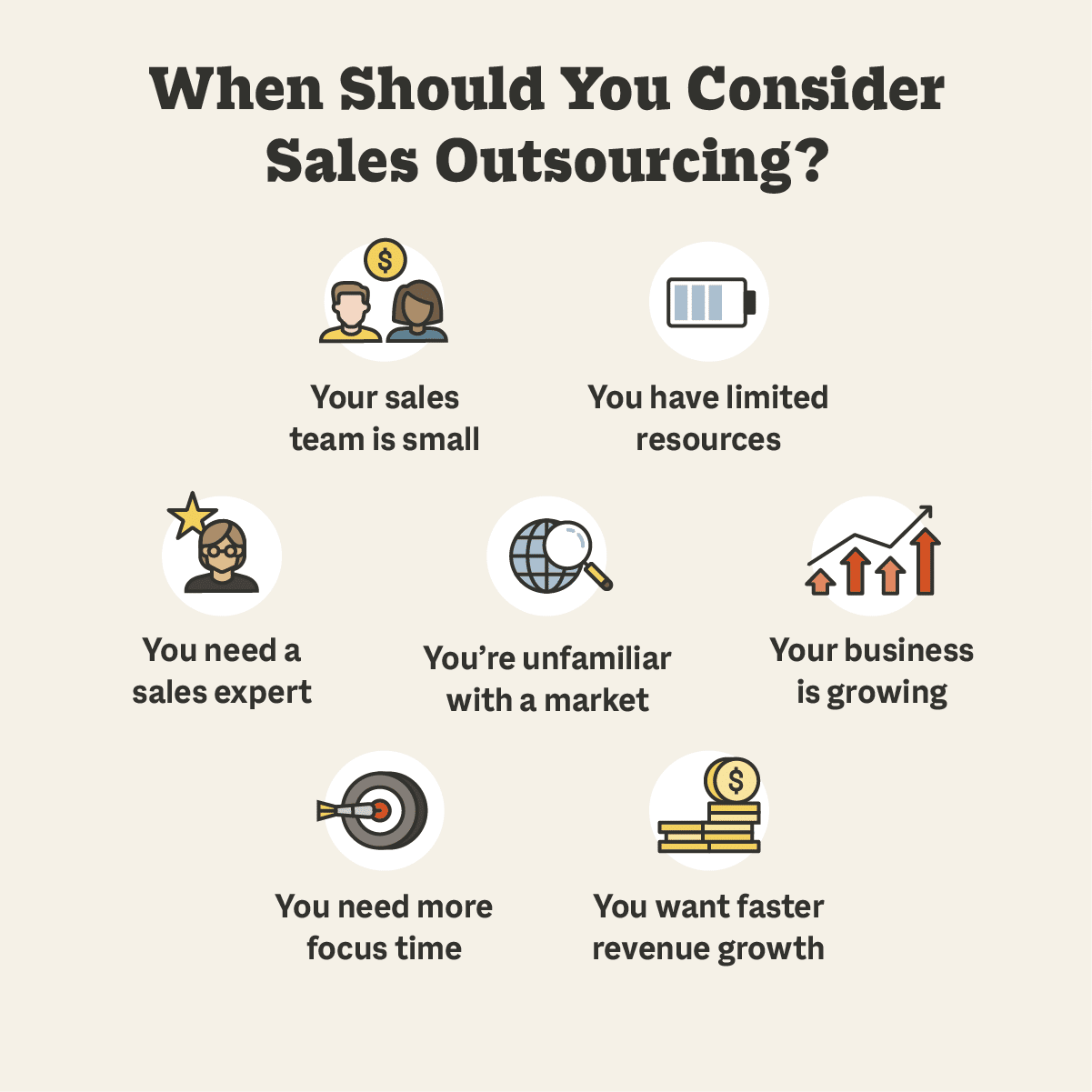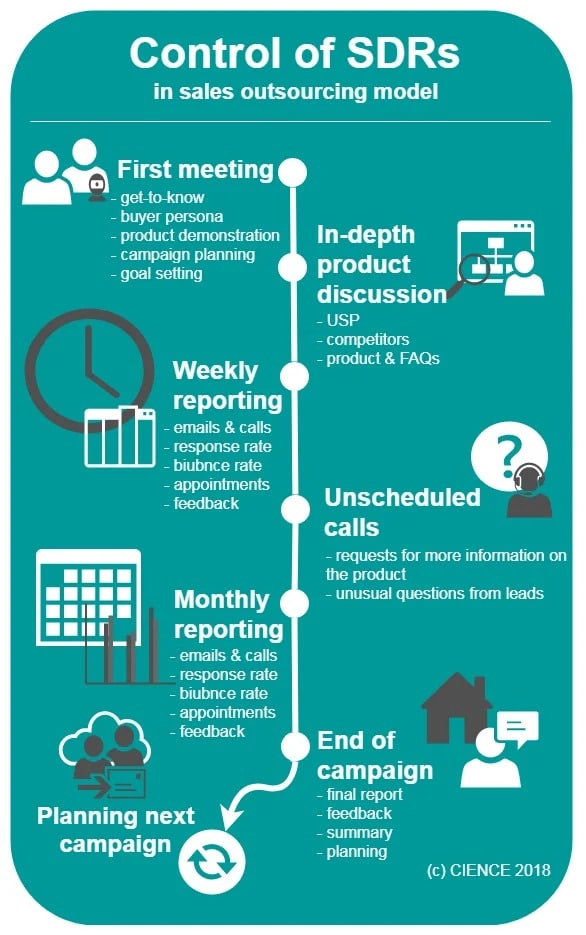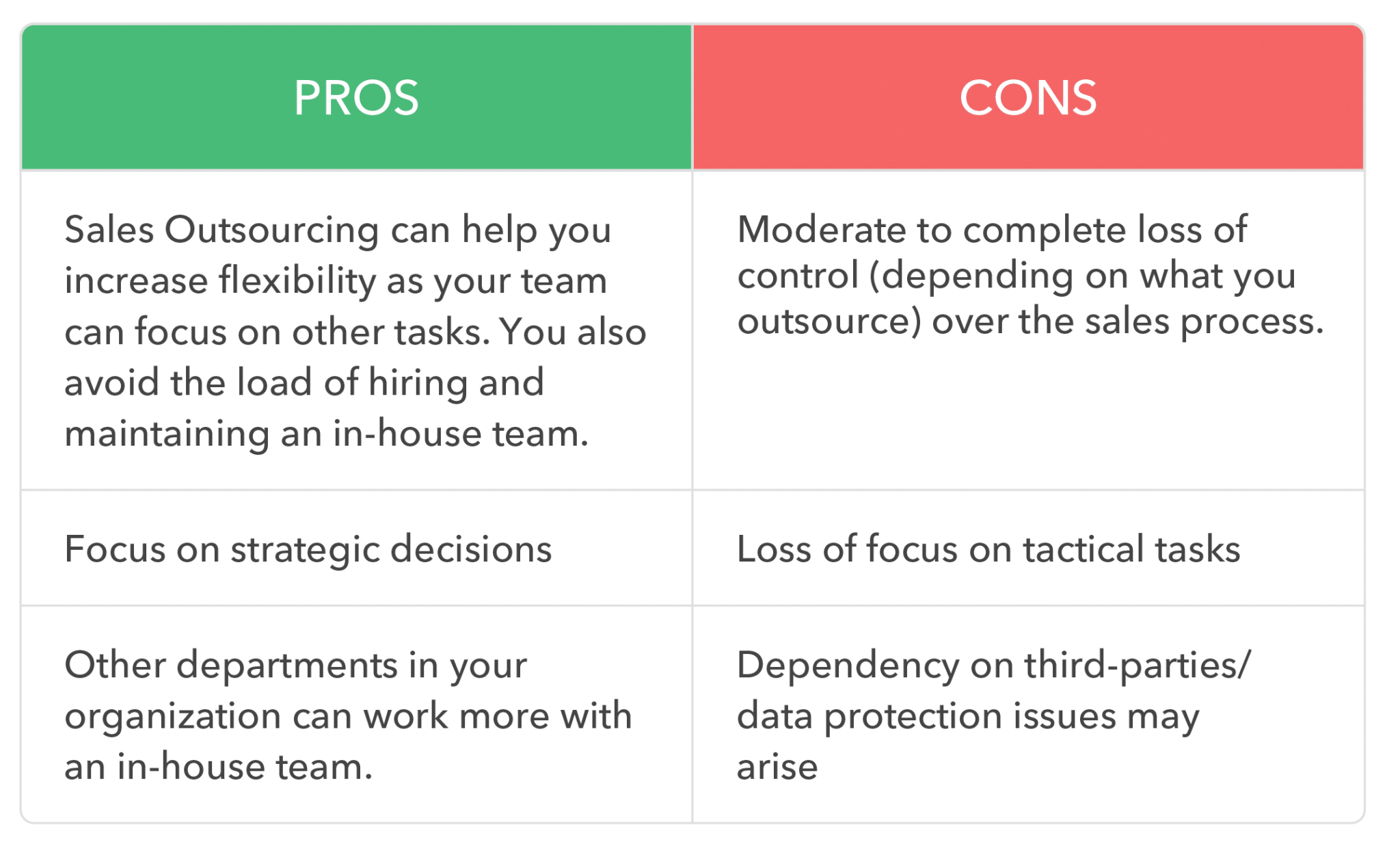We generally call on an outsourced sales force for a specific aspect of the sales process: prospecting, qualification, or cross-sell or upsell campaigns.
For this to work well, you need to choose the right service provider, have clear, established sales processes, and the interface between the external sales force and the internal sales force needs to be very clear.
The main risks in outsourcing are in the image of your brand, product and company with prospects and customers, and in project management (delays, hidden costs, lack of performance, etc.).
In this article, we give you an in-depth definition of this concept, the situations in which it may be worthwhile to call on external teams, some advice and the risks and drawbacks of this method ofbusiness outsourcing.
Sommaire
Outsourced sales force VS Substitute sales force: Definition
The term “auxiliary sales force” is generally used to describe a sales force that supplements an already established and stable sales organization. The outsourced sales force would then be the total outsourcing of the sales force.
But whatever outsourcing format you envisage, sales outsourcing can only work if you already have an established sales process.
In practice, the external sales force is generally involved in a specific aspect of your sales process: prospecting, qualification, upsell or cross-sell campaigns. The idea is that there needs to be a clear interface between the in-house sales team and the outsourced sales force, so that both teams can work efficiently.
When should you use an outsourced sales force?

Outsourced sales prospecting
There are many prospecting agencies (in France or offshore), and the most common B2B format is a contract for a sales appointment.
Agencies generally commit to a certain number of appointments (per month, for example), and you pay a fixed rate for each appointment, or you agree on a commitment of means, usually with performance safeguards.
The discovery meeting and the entire negotiation and closing phase are usually handled by an in-house team with in-depth knowledge of the company’s products and processes.
This is the most frequent case, because prospecting is one of the thorniest issues for sales teams. Despite all conceivable optimizations, success rates soon reach a glass ceiling, and the only way to boost performance is to increase volume.
But it’s also one of the least structuring aspects for a sales team, in the sense that prospecting efforts are fairly independent of the product or market, and highly dependent on the person making the phone calls, managing the cold mailing campaigns, and so on.
The bulk of the cost of building a high-performance prospecting team lies in recruitment, training and managing a team. And even if the start-up nation got a little carried away in the days of low interest rates and wildly inflated valuations, it actually makes little sense to invest heavily in a prospecting platform when many agencies are doing it very well.
Manage a variable volume of incoming leads
One of the main reasons for turning to an outsourced or back-up sales force is when you can’t handle the volume of inbound leads. A good problem on paper, but not always.
For example, if your business is highly seasonal, it’s highly inefficient to recruit, train and manage a team of sales people all year round to meet a peak demand two months out of the year.
This is where a back-up sales force comes into its own. A support team can be set up in a matter of weeks to handle all incoming leads, drastically reduce sales cycles and limit opportunity costs.
In detail, these teams generally intervene in the less critical aspects of the commercial value chain, for example to ensure the commercial qualification phase, before handing over to established teams for the negotiation and closing phases.
New product or market
This is another classic of commercial outsourcing. Your sales organization is structured and efficient for a given product range and geographical area. And you’re launching a new region, or a new product range.
Reorganizing your team to integrate this market represents not only a major cost, but also a major risk. You can’t change a winning team, as they say.
Entrusting this new market to an external sales force limits the risks and resistance to change. Better still, if it’s done right, it can introduce healthy competition between the Internet team and the back-up sales force, helping to integrate (or at least limit the apprehension of) the new market into existing processes.
Fully outsourced sales force: a myth?
In theory, the entire sales process can be outsourced to a service provider. Once the sales process is well defined, the KPIs known, and the commercial relationship minimal, it’s easy to imagine outsourcing the entire sales force.
But if you go back to business strategy courses, outsourcing is traditionally reserved for “non-critical” activities – i.e., if you take a shortcut, activities where the company can’t really differentiate itself from the competition.
And it’s very complicated to sell without differentiation.
External sales force: key success factors
Choose your supplier carefully
When you’re looking at an external sales supplier, you need to be interested in what they can do for you. You can take a look at his experience, the type of billing he offers, his previous customers and his availability.
Don’t forget to get in touch with companies that have already contacted us, and listen to any recommendations they may have.
Above all, your supplier must be able to work with sales processes similar to yours. Several of them offer case studies to give you an idea of their services, so don’t hesitate to consult them.
Having these points in mind before you start looking for a partner will make it easier and quicker to choose a partner with the same business ethics as you!
Agree on basic principles
Once you’ve chosen your service provider, it’s time to define your work priorities and what’s really important to you. For example, you can provide detailed documentation on your product and what you want to achieve, so that your service provider has a clear idea of your expectations.
Don’t forget to take into account the return on investment (ROI) you want to maintain, and the various key performance indicators defined for your supplier.
This step will enable us to agree on the basic principles and to better understand the next stage of the collaboration.

Establish close collaboration between in-house and outsourced teams
The third step is to connect your teams with your supplier’s teams and start the collaboration process. This is crucial for defining unique value propositions, refining your key performance indicators or improving the marketing campaigns you implement.
This collaboration can also be an opportunity to reflect on the pricing that was defined at the start of the collaboration.
The aim of all this is to ensure that internal and external teams participate in the process together, and don’t see themselves as competing adversaries. Don’t forget thatSales/Marketing alignment is essential to your sales success!
Active communication
Once you’ve chosen the agency you want to work with and established the working processes, make sure you know how the service will evolve. For example, you can talk to your supplier on a regular basis to check that the work supplied meets your expectations.
These exchanges are also an opportunity to share your latest ideas, or express any concerns you may have. You can then agree with the service provider on the work to be carried out.
Don’t expect immediate results
You may not see the effects of your service provider’s efforts right away. And that’s normal!
If you want to encourage, or even accelerate, results, make sure your service provider has everything they need, and encourage immersion in your product.
Outsourced sales force: Risks and drawbacks

Unforeseen expenses and hidden costs
An outsourced sales force has a number of disadvantages that can be quite damaging to your business. One of the risks is that outsourcing may entail expenses you hadn’t planned for, and which you end up having to pay during the project development phase, such as the purchase of software, or in general of any technical, legal or marketing support.
So make sure you know right from the start what the overall cost will cover. And if your service provider is asking for a financial contribution, you could suggest, for example, that they look for open source alternatives to the software they need. You can also ask him to specify the different scenarios in the contract, and the associated prices.
Data security
One of the major risks of outsourcing concerns the protection of your data, which could be disclosed by your service provider.
To avoid this risk, the most common method is to sign a confidentiality agreement (NDA) with the service provider at the start of the project. It guarantees that all the information you share with us will remain confidential. This document also makes it possible to agree on the consequences of disclosing your data.
Constant delays
Your project may take longer than expected, whether due to delayed communication, inaccuracies or poor project management. Delays can also be caused by inaccurate estimates during the project definition phase, which prevent the project from progressing properly.
To reduce this risk, make sure you communicate regularly with your service provider and draw up a contingency plan in advance. Your teams and those of your service provider will react better if they know how to handle a situation you’ve anticipated!
Poor management of remote teams
Team management (internal and external) is super-important if your project is to progress as you want it to. One of the biggest risks of remote management is a communication gap between your team and your service provider’s team. This can easily lead to external teams not meeting the deadlines you’ve set, for example.
All the conditions for project success that you define together at the outset must ensure that all teams are clear about the tasks they need to carry out.
To best manage this risk, one solution is to rely on communication channels like Slack so you can directly ask your questions to external teams.
Going further
- If you’d like to learn more about team management and management training, I invite you to browse through our various articles on the subject!
- Management and leadership coaching: the complete guide
- Top 10 best project management courses
- The best sales training courses to boost your sales
Communication barrier
According to a study conducted by PDI, 25% of outsourced projects fail due to poor communication. Beyond the communication problems inherent in communication, there are slightly deeper problems.
For example, depending on the service provider you use, you may be confronted with differences in organizational culture or a language barrier. If you choose to work with a service provider located in a country other than your own, I strongly recommend that you find solutions right from the start of the project.
Make sure, for example, that all your teams have a decent level of English, or that the timetables you set are convenient for everyone in the event of any time differences.
Poor final product quality
One of the risks of outsourcing is that you can never be 100% sure of the quality of the final product. Recent research indicates that 45% of organizations outsource IT projects to optimize costs. It’s a perfectly understandable strategy, but one that can fall flat on its face if your final product is of poor quality.
There are several ways to manage your risk. You can ask your service provider to provide you with samples of the work they’ve done so far to check that it’s right for you. To ensure that your product meets your standards, make sure your supplier has detailed specifications. Some agencies even offer to sign a Service Level Agreement.
Lack of customer knowledge
To meet your expectations, your supplier needs to understand your business. If external team members don’t have sufficient knowledge of your products or field, outsourcing can be expensive and take longer than expected.
Make sure your provider has the necessary knowledge, and if not, make sure they’re committed to acquiring it.
Lack of process control
When choosing your supplier, make sure they are transparent with you and willing to offer you customized work. It can be hard to pin down, but it’s the key to maintaining control over your product’s development.
You can, for example, propose a work schedule with regular meetings, monitor product updates or appoint a person to keep you informed of each stage in the project’s development.
This is essential to build a relationship of trust and minimize the risk of getting a final product that doesn’t meet your requirements.






